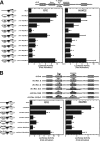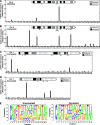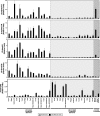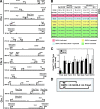Molecular hallmarks of endogenous chromatin complexes containing master regulators of hematopoiesis
- PMID: 18779319
- PMCID: PMC2573226
- DOI: 10.1128/MCB.01061-08
Molecular hallmarks of endogenous chromatin complexes containing master regulators of hematopoiesis
Abstract
Combinatorial interactions among trans-acting factors establish transcriptional circuits that orchestrate cellular differentiation, survival, and development. Unlike circuits instigated by individual factors, efforts to identify gene ensembles controlled by multiple factors simultaneously are in their infancy. A paradigm has emerged in which the important regulators of hematopoiesis GATA-1 and GATA-2 function combinatorially with Scl/TAL1, another key regulator of hematopoiesis. The underlying mechanism appears to involve preferential assembly of a multimeric complex on a composite DNA element containing WGATAR and E-box motifs. Based on this paradigm, one would predict that GATA-2 and Scl/TAL1 would commonly co-occupy such composite elements in cells. However, chromosome-wide analyses indicated that the vast majority of conserved composite elements were occupied by neither GATA-2 nor Scl/TAL1. Intriguingly, the highly restricted set of GATA-2-occupied composite elements had characteristic molecular hallmarks, specifically Scl/TAL1 occupancy, a specific epigenetic signature, specific neighboring cis elements, and preferential enhancer activity in GATA-2-expressing cells. Genes near the GATA-2-Scl/TAL1-occupied composite elements were regulated by GATA-2 or GATA-1, and therefore these fundamental studies on combinatorial transcriptional mechanisms were also leveraged to discover novel GATA factor-mediated cell regulatory pathways.
Figures







Similar articles
-
Discovering hematopoietic mechanisms through genome-wide analysis of GATA factor chromatin occupancy.Mol Cell. 2009 Nov 25;36(4):667-81. doi: 10.1016/j.molcel.2009.11.001. Mol Cell. 2009. PMID: 19941826 Free PMC article.
-
The Hematopoietic Stem and Progenitor Cell Cistrome: GATA Factor-Dependent cis-Regulatory Mechanisms.Curr Top Dev Biol. 2016;118:45-76. doi: 10.1016/bs.ctdb.2016.01.002. Epub 2016 Feb 26. Curr Top Dev Biol. 2016. PMID: 27137654 Free PMC article. Review.
-
The paralogous hematopoietic regulators Lyl1 and Scl are coregulated by Ets and GATA factors, but Lyl1 cannot rescue the early Scl-/- phenotype.Blood. 2007 Mar 1;109(5):1908-16. doi: 10.1182/blood-2006-05-023226. Epub 2006 Oct 19. Blood. 2007. PMID: 17053063
-
Tal1/SCL binding to pericentromeric DNA represses transcription.J Biol Chem. 2005 Apr 1;280(13):12956-66. doi: 10.1074/jbc.M412721200. Epub 2005 Jan 27. J Biol Chem. 2005. PMID: 15677454
-
[Genetic control of hematopoiesis].C R Seances Soc Biol Fil. 1997;191(1):105-11. C R Seances Soc Biol Fil. 1997. PMID: 9181132 Review. French.
Cited by
-
Angiopoietin-2 is a direct transcriptional target of TAL1, LYL1 and LMO2 in endothelial cells.PLoS One. 2012;7(7):e40484. doi: 10.1371/journal.pone.0040484. Epub 2012 Jul 6. PLoS One. 2012. PMID: 22792348 Free PMC article.
-
Human GATA2 mutations and hematologic disease: how many paths to pathogenesis?Blood Adv. 2020 Sep 22;4(18):4584-4592. doi: 10.1182/bloodadvances.2020002953. Blood Adv. 2020. PMID: 32960960 Free PMC article. Review.
-
Exploiting genetic variation to uncover rules of transcription factor binding and chromatin accessibility.Nat Commun. 2018 Feb 22;9(1):782. doi: 10.1038/s41467-018-03082-6. Nat Commun. 2018. PMID: 29472540 Free PMC article.
-
GATA1 Activity Governed by Configurations of cis-Acting Elements.Front Oncol. 2017 Jan 9;6:269. doi: 10.3389/fonc.2016.00269. eCollection 2016. Front Oncol. 2017. PMID: 28119852 Free PMC article. Review.
-
Occupancy by key transcription factors is a more accurate predictor of enhancer activity than histone modifications or chromatin accessibility.Epigenetics Chromatin. 2015 Apr 23;8:16. doi: 10.1186/s13072-015-0009-5. eCollection 2015. Epigenetics Chromatin. 2015. PMID: 25984238 Free PMC article.
References
-
- Altin, J. G., D. A. Kujuba, S. Raffioni, D. D. Eveleth, H. R. Herschman, and R. A. Bradshaw. 1991. Differential induction of primary response (TIS) genes in PC12 pheochromocytoma cells and the unresponsive variant PC12nnr6. J. Biol. Chem. 2665401-5406. - PubMed
-
- Anderson, K. P., S. C. Crable, and J. B. Lingrel. 1998. Multiple proteins binding to a GATA-E box-GATA motif regulate the erythroid Kruppel-like factor (EKLF) gene. J. Biol. Chem. 27314347-14354. - PubMed
-
- Bembom, O., S. Keles, and M. J. van der Laan. 2007. Supervised detection of conserved motifs in DNA sequences with cosmo. Stat. Appl. Genet. Mol. Biol. 6Article 8. - PubMed
Publication types
MeSH terms
Substances
Grants and funding
LinkOut - more resources
Full Text Sources
Molecular Biology Databases
Research Materials
Miscellaneous
